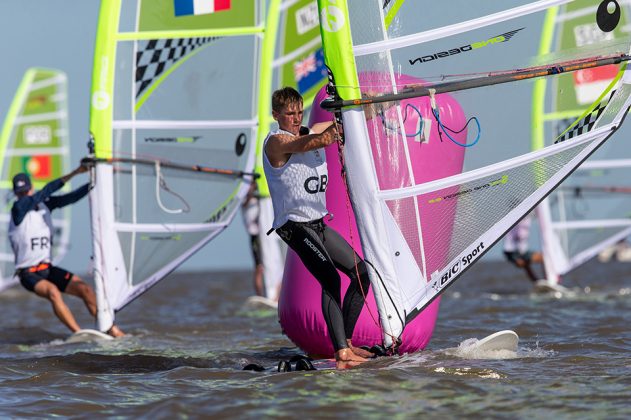Youth Olympic bronze medallist Finn Hawkins gives us his top racing tips!
Words Finn Hawkins // Photo Matias Capizzano/World Sailing
1. Do the preparation
You’ve probably heard it all before, but it is so important. Firstly make sure you’ve checked all your equipment before you go to an event so nothing is likely to break. Read the notice of race and the sailing instructions so you know the courses that you will be racing around and any additional information you will need when racing such as the first possible start times and class flags. Lastly, check the forecast so you know what you might be faced with – this will help you decide what wetsuits and clothing to bring and any extra equipment you might have to take.
2. Launch as soon as you can
It is very important to be on the water as soon as possible so you can get some valuable things done to improve your racing. Not only will this will ensure you will not miss your race but also it allows you to sail a fraction of the course where you can gather information such as where the buoys are laid and to see if that is going to affect your race in anyway. It is very hard to set a perfect course, so more often than not there will be buoys out of position and this will affect which tack you are likely to sail on first. It will also let you see what course you will be sailing and get some pre-starts done on the start line without it being too busy.
3. Remember your training
Racing can be a physically and mentally intense and a challenging environment where sailors can forget the valuable skills they have been taught in training. I have trained with many people who can go fast in training and demonstrate good skills but then struggle to implement their speed and skills in racing. To combat this, write down the key things you have been taught or think about when going fast so you can remember and hold onto these points when racing. Also, there is no substitute for time on the water practicing the things you have been taught – this will help it be more natural when racing.
4. Starting
Starting is by far the most important part of the race. You can’t win a race from the start, but you can definitely lose one. Before you leave the beach make sure your watch is attached to the mast and that it’s working. When starting, the most important thing is to know where the line is – the easiest way to do this is to take a transit. This will make sure you know how far off the start line you are so you know when to accelerate. If you are not the most confident starter then start near the bias end but not on it so you are not giving away too much ground on the start line but you are away from the carnage. By bias I mean the end that allows you to cross the start line the quickest. Making sure your start links in with your race plan is also crucial. For example, if you know going to the left side is the quickest way to the windward mark you would most likely want to start near the left side of the start line.
5. Mark roundings
The easiest way to practice this is on your own around a buoy. Usually you will be taught to go in wide and come out tight. However, sometimes in racing this is not possible and it is important to practice coming into a mark tight and exiting tight. If you can successfully do this you will be able to do this next tip comfortably. The rule we will be using is rule 18 in the windsurfing rule book: mark room. This rule simply means that if you are the inside board while rounding a mark you have right of way. If you can be the inside board at almost every single mark then you are guaranteed to take a place or stay in the same place every time if you can do a successful mark rounding. Every place in a series counts so this helps hugely in the overall results.
6. Sail to your strengths
It is important to identify what you are good at and use this to your advantage. For example, if you can go really fast but can’t point very high into wind it would be best to leave yourself with a big gap to leeward off the start line and when racing so you can use your speed without having to pinch out of fear of being rolled. One of my strengths is being able to point quite high upwind, and I use this to pinch out people above me on the start. Although this is very useful I have to be weary of people going fast and coming over the top of me so I need to be able to adapt and go fast again. In an ideal world we would be high and fast, this is why it is important to practice your speed and upwind ability so we don’t have to worry about these things as much. I was once told, speed makes you a tactical genius. This is very true and it definitely helps to get to the front of races. Despite this, you still need to be making the right decisions because going fast doesn’t necessarily mean you are going to win if you are going the wrong way. However, it still might be better than going slow in the right direction!

